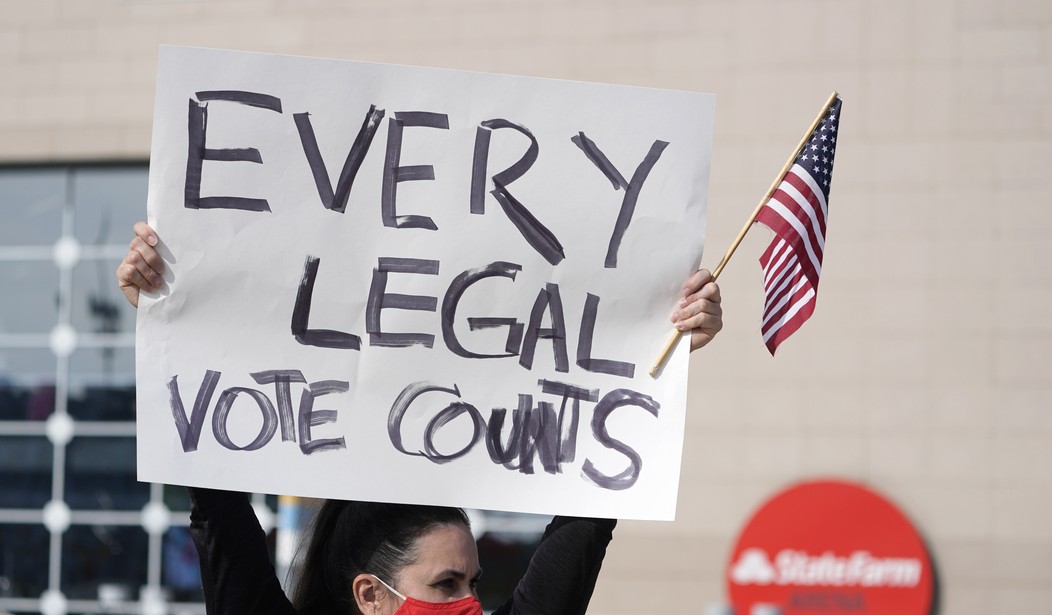My grandfather used to say, “Men fought for your right to vote. Including Uncle Harry. You should honor them by never missing an election.” His brother, my great uncle Harry, took shrapnel from a German mortar in France and limped forever because of it. I’ve only missed one vote in my life.
Voting is only important if everything is on the up-and-up. Fake ballots, altered ballots, and illegal voters are just a few ways to deny Americans one of the things that make our nation special: the right to pick our leaders and vote out commies like Joe Biden those who don’t represent our values.
I recently published an article about Redo Voting, a transparent, unhackable way to vote, or shall I say, a way for legal voters to cast a ballot. It is a Democrats’ nightmare and everyone in Washington, D.C. is talking about it.
Our loyal PJ Media readers have overloaded us with comments, critiques, and questions regarding Redo Voting. The dedicated Americans at Redo Voting have taken the time to address the concerns in your comments. Here are the answers to some of your verbatim questions. Here is my personal favorite:
Q. They’ll find some excuse to call it racist.
A. Probably, but it won’t be a valid excuse.
Great answer! I love the crew at Redo Voting!
Ok, so here are some of the concerns you folks have posed:
Q. Does Redo Voting replace paper, in-person ballot casting?
A. It can, but it can also reflect in-person accountability or be performed at a polling station. Additionally, Redo Voting is compatible with any voting system in existence.
Q. The article did not clarify how the QR code matches up to the individual voter who has obtained one. Nowhere does it say you have to prove you are a registered voter to get a card. Anyone can pick up and
scratch-off a card, or a hundred cards.
A. The article does not articulate this, but the website does. It is the 14th question under the FAQ tab.
• A voter enters the facility and requests a ballot.
• The attendant asks for identification (driver’s license or state-issued ID) as if the voter was purchasing
alcohol or cigarettes.
• The attendant scratches off the rectangular pad under the state seal to reveal a bar code and scans it with
the same scanner used in their existing transaction infrastructure.
• The attendant scans the bar code on the back of the voter’s driver’s license or state-issued ID.
• The credit/debit card terminal prompts the voter to create and enter a private four-digit PIN. The ballot is now associated with that voter and that voter only. On election day when the voter scratches off the first QR code to complete or update their voter registration, they will have to enter their four-digit PIN to access their ballot slate with the second QR code.
Q. How does the system know who are registered, eligible voters? What about states where they register anyone?
A. Different states have different laws regarding who can vote in local and intra-state elections. Based on state and federal laws, the Redo Voting system uses the information from the encrypted PII hash to determine what, if any, elections the registrant is allowed to vote and assembles their ballot accordingly.

Q. How does Redo Voting make sure that the person casting the ballot is in fact the person whose identity has
been used to open the ballot?
A. A state-issued ID must be presented and scanned to activate a ballot. Real ID makes each state-issued ID a fraud-resistant secure document.
Q. How does Redo Voting make sure someone else cannot cast a ballot in my name?
A. You obtain your ballot by showing a state-issued ID, which you secure by creating a four-digit PIN. Once you vote, your registration is closed until the next election.
Q. How does Redo Voting deal with the issue of inaccurate voter rolls (such as dead voters, moved voters)? There are a tremendous number of these.
A. Because registering a ballot requires presenting a state-issued ID, people who are fraudulently on voter rolls can’t vote unless they figure out how to bypass the state’s standard for secure, fraud-resistant IDs.
Q. How does Redo Voting deal with the last-minute college student who registers?
A. If they are over 18, they are required to have a valid state-issued ID. Their process is exactly the same as everyone else’s.
Q. How does Redo Voting deal with the issue of non-citizens being authorized to vote (like New York City did and they get to have driver’s licenses)?
A. To procure a state-issued ID, an applicant must by law disclose their citizenship or immigration status. The Redo Voting system uses the information from the encrypted PII hash drawn from the state ID registry to determine if the registrant is eligible to vote.
Q. How does Redo Voting deal with attempts at spoofing?
A. Ballots can’t be spoofed because they are serialized. Registrations can’t be spoofed because they require
the presentation and scanning of a secure, state-issued ID to obtain an activated ballot. QR codes can’t be spoofed because no one but the voter ever actually sees them.

Q. How does Redo Voting prevent the establishment of fraudulent driver’s licenses/voter records? Could someone just invent people and use that to stuff the ballot box?
A. If someone was able to secure a fraudulent state-issued ID card, they could theoretically vote twice. That would depend rather heavily, however, on showing up at the DMV each time with a different set of fingerprints.
Q. How does Redo Voting stop people from gathering up multiple voter identities and abusing the vote that way, to vote as multiple people? “How does it know I’m me? How does it not know I’m an employee whose information, including a driver’s license, I might have?” I saw something like this happen in Patterson, N.J.
A. As suggested above, gathering up multiple voter identities could work IF you could fool the DMV into ignoring ID issuing safeguards and could change your fingerprints at will.
Q. How does Redo Voting prevent someone from buying a phone in a dead person’s name and voting. If a dead person is still on the voting rolls and a phone is bought in their name then the dead can still vote, right?
A. OK, this is important … Redo Voting IS NOT A VOTING APP. All a smartphone provides in this process is a camera that can recognize QR codes and an internet browser.
Q. How does Redo Voting ensure that someone cannot simply create a voter or use identity theft to fabricate a
ballot from someone who is dead, no longer lives in the state, or does not normally vote?
A. Unless they go to the DMV and impersonate these people right down to the fingerprints, this seems unlikely.
Q. How does Redo Voting stop someone from attempting to vote a second time?
A. Once a registration has been voted on once, it deactivates until the next ballot activation.
Q. How does Redo Voting stop someone from selling the valid scratch-off to someone else?
A. Buying one seems like a really dumb thing to do. The purchaser can’t use it anyway without the four-digit PIN, and the seller only gets one ballot. Why not just accept a bribe to vote a certain way, then vote the way you were going to anyway because there is no way they can tell who you voted for?
Q. How does Redo Voting ensure that the medically confined can vote without fear of the Wisconsin experience of ballot harvesting in long-term care facilities?
A. This is really a social services issue. Ballot harvesting is not technically possible because the ballots have to be activated, but undue influence might be. We would recommend that the state treat shut-ins as absentee voters who send in for a ballot. The budget saving from using Redo Voting could be redirected to establishing non-partisan voting teams dispatched by the Secretary of State’s office to long-term care facilities for registration, ballot, and voting. The team could come one day to register voters and activate ballots, then a different team comes in on election day to facilitate voting. That way, the voting team would not know the four-digit PINs and could not coerce a voter. All they would need is a scanner and a tablet.
KDJ note: Wisconsin usually sends two “voting deputies,” one Democrat and one Republican, to oversee the voting in health care facilities. The Wisconsin Election Commission illegally decided to drop them in 2020 “because of COVID.”
Q. ACCESSIBILITY: How does Redo Voting work for those who do not have a smartphone? I’m not sure why it is thought that Democrats would hate it. I’m a Democrat and I love the idea. The problem, though, is there has to be a way for people who don’t own computers to be able to do it, otherwise, this just becomes another way to suppress the vote.
A. They don’t need a smartphone. All they need is an activated ballot and an internet browser. Any public library can assist.
KDJ note: I wrote that Democrats will hate the Redo Voting system because there is a Matterhorn of evidence that Democrats cheated in the 2020 election (mad bomb shouts to Kruiser for the word “Matterhorn”). Check this out.
Q. How does Redo Voting deal with the issue of coercion or bribery to get someone to vote the way an observer wants them to vote? How does it still ensure that someone could vote privately? There would have to be a fix for vote harvesting for this system to work.
A. How on earth would that even work? Unless someone who wanted to do that happened to grab you when you had your activated ballot on you, was near a computer terminal they could access, and was able to get away with doing this in front of witnesses, I don’t see how that would be possible. All the voter would have to say is “no” or “I already voted” and tear their ballot across a QR code. When they leave, go to an outlet, get another ballot, and activate it.
Q. Question about the secrecy of the vote. With this proposed lottery-technology voting system, the vote-harvesting mules would just carry around a phone or laptop with a web browser when going to nursing homes and homeless shelters to pressure seniors or bribe the indigent to vote certain ways that the vote-harvester would then see on the laptop. In such a way the secret ballot is broken and the vote harvester has the ability to coerce or bribe the voter to vote a certain way while verifying that the vote is cast as the harvester wants.
A. Without a system to activate the ballots, this could not be done. That is why the Secretary of State would use non-partisan voting teams dispatched to long-term care facilities for registration, ballot activation, and voting. The team could come one day to register voters and activate ballots, then a different team comes in on election day to facilitate voting. That way, the voting team would not know the four-digit PINs and could not coerce a voter. All they would need is a scanner and a tablet.
Q. How does it address ballot secrecy (the Australian ballot): how does Redo mitigate the risk of someone standing over the voter’s shoulder in a way that the Australian ballot (the voting booth/private computer screen at the polling place) does?
A. With Redo Voting all you need is an internet browser. You can vote on your phone on the toilet if you want to. If someone is standing over you then, you might have a different, more pressing problem. If voting takes place in a polling place, there is no reason why the terminal could not be sheltered the same way voting booths are now.
Q. How does Redo Voting stop manipulating the election by selective internet outages? How does Redo Voting prevent “man-in-the-middle” attacks that might disrupt the ballot transmission? Can the ballot be intercepted in the cloud and stopped?
A. All you need is an internet browser. On a phone, this could be done with a cellular signal. Despite the profound unlikelihood of this scenario, let us consider a catastrophic failure of the internet. Because ballot activation is also done over the internet, registration would not be affected. The election could be suspended until the internet service is restored then resumed unaffected. Let us assume the internet is a troubling phone call and the election is a sandwich. You leave the table and close the door to take the troubling phone call, but when you open the door and return to the table you can simply resume eating your sandwich.
The cloud is infinite and each ballot has a one-way encryption hash. Even if they can find it, which is about a one in three billion chance, they can’t open it. They also probably can’t find the digital repository for the same reason. As the votes go in, no one can tell what the contents of the vote are. What point is there to shredding votes when you don’t know what they are? Viewing access to watch the votes come into the repository can be given to anyone the Secretary of State desires, but neither he nor any other spectator can know who the votes are for until the polls close and the Secretary of State publishes the decryption key. Then, every interested party can do their own tally of the votes and they will all come up with the same totals. All of this is done with open-source, public code.
Q. INTEGRITY: How is the voting process made safe from manipulation from inside the government, by clerks or elected officials manipulating vote tallies or the voter database?
A. There is no middle man, and neither clerks nor government officials have access to the process during the election. Your encrypted vote goes straight to a secure digital repository, and until the decryption key is published NO ONE can see who you voted for in any race except you. If you scratch off the review pad on your ballot and scan the QR code, it takes you to a printable PDF version of your ballot. You are the only person who will ever be able to see it because you are the only one with that QR code. When the polls close and the decryption key is applied, everyone knows the exact results immediately and simultaneously, the votes themselves remain anonymous, and it is 100% mathematically provable.
Q. How does Redo Voting ensure that the voting machines, the tabulating machines, and the reporting machines have all been programmed to give an accurate count? (that batches of votes are not run through a tabulator multiple times, and so on).
A. Redo Voting does this by ensuring there are no voting machines involved in the process.
Q. What assurances can be given that the voter roll database administrators will not abuse the database? How do we trust the government employees here?
A. Unless database administrators are given free rein over the state ID card registry, it does not matter. If they are, computer access logs will confirm by whom and from where the tampering was done.
Semi-conclusion:
We could go on and address more concerns, and I suspect we will in Pt. II, but every time we get this article written, 70 more concerns are posted. Stay tuned.










Join the conversation as a VIP Member